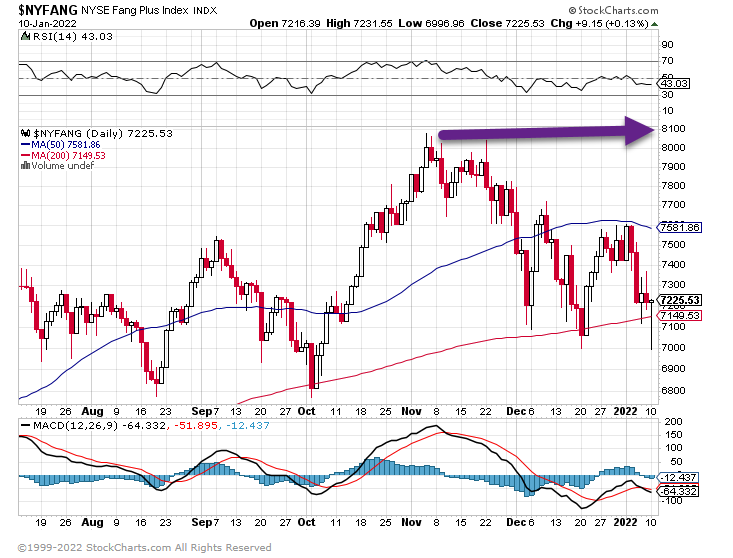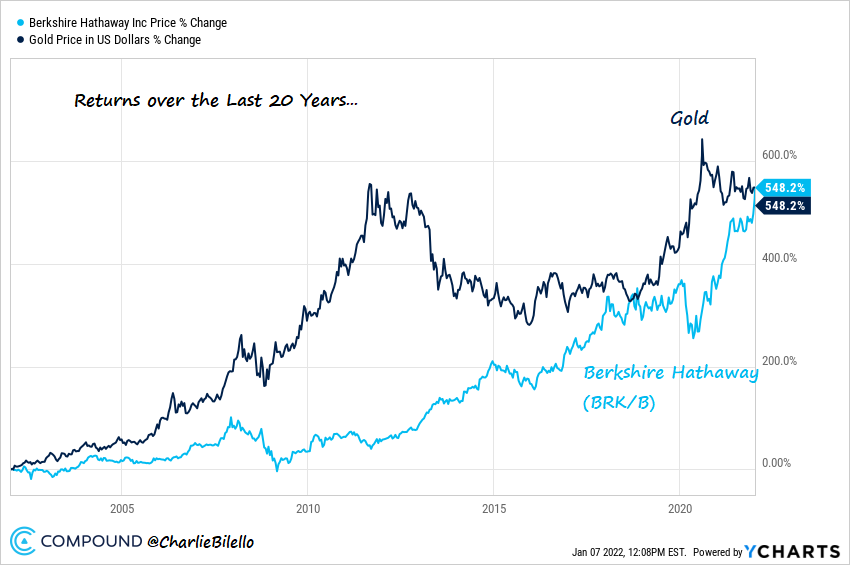1. Fang Plus Index Holds 200 Day Moving Average.
FANG fails to top November highs….trades below 200 day most of yesterday but rallies to close above….

2. Nasdaq Comp Same Story….
Never breaks above November highs….holds 200day yesterday on afternoon rally.

3. MGC-MegaCap Tech ETF did Break November Highs.
MGC-made new highs and pulled back less than FANG and Naz Comp

4. ARKK Almost Cut in Half Mark.
ARKK approached the -50% from highs levels intra-day yesterday.

5. Nasdaq Averages Four 5% Pullbacks Per Year Going Back to 1972
Dorsey Wright–The Nasdaq Composite NASD has had a rocky start to 2022, with the index posting its fourth consecutive daily loss on Friday. In fact, the NASD has seen a decline in eight out of the last ten trading days. With Friday’s decline, the Composite has now pulled back over 5% from its closing value on December 27. There were a total of four 5% pullbacks in the NASD during 2021, which is right at the annual average dating back to 1972. There was only a 37-day gap between the last 5% pullback at the beginning of December and the most recent one, which is much quicker than the 92-day average gap between prior pullbacks. This also marks the swiftest 5% pullback since June 2020 at just eleven calendar days.


6. Pure Growth Factor Had Its Worst Week Ever Relative to Pure Value.

7. This Chart Shows KRE-Regional Bank Stocks vs. S&P to Start 2022 Massive Spike in Outperformance.
Jan 1. 2022 Bank Spike Vs. S&P

8. Gold and Warren Buffett Even 10 Year Performance.
@Charlie Bilello Same Outcome, Different Paths
It’s no secret that Warren Buffett is not a fan of Gold, having denounced the metal as an investment on numerous occasions.
While there’s no denying Buffett’s huge long-term outperformance versus Gold, over the last 20 years they look exactly alike, with a return of +548%. Same end point, but very different paths getting there (first 10 years belonged to Gold, and the last 10 years to Buffett).

9. Suburban Housing Seeing Favorable Polls
Pew Research-Americans Are Less Likely Than Before COVID-19 To Want To Live in Cities, More Likely To Prefer Suburbs

https://www.pewresearch.org/social-trends/2021/12/16/americans-are-less-likely-than-before-covid-19-to-want-to-live-in-cities-more-likely-to-prefer-suburbs/
10. The Best Job Candidates Are the Best Storytellers
HBR by Kelsey Schurer
Summary. A successful job interview hinges on a great story. A great story takes the audience on a journey. It has a clear beginning, middle, and end. The “before” version of you was met with a challenge that forced you to learn, grow, and ultimately do something differently. You…more
Where your work meets your life. See more from Ascend here.
Before the pandemic, and I do mean way before, I bought a beautiful suit — deep charcoal gray with a soft silk lining. It was my interview suit.
I’d just graduated from my Master of Fine Arts program and believed that first impressions were all about how we presented ourselves. This, to a degree, is true. But in the interview room, that presentation tends to stay on the surface. Of course, you need to speak intelligently and concisely, and you need the skills and experience to qualify for the roles you’re applying for. Still, as I stared at myself in my nice suit in the mirror, I naively forgot that first impressions extend far deeper.
First impressions are meant to impress. The word “impress” has more than one meaning; the most common is to gain admiration or interest. But to impress also means to imprint, or to apply so much pressure or intent upon something that you leave a permanent mark behind.
If you think about it, the pandemic applied that pressure, imprinting us with the desire to reexamine what’s important in our lives — especially our work lives. Some of us were left with more than just a need to switch jobs, but also a radical wish for more flexibility, money, and happiness in our careers.
If you’re one of the people seeking a new work opportunity, then you’re probably prepping for a job interview (or a few).
Here’s what not to do:
- Spend all your time memorizing facts about the company and role: Learning as much as you can about the company you’re interviewing with is smart, but everyone does this. The interviewer knows what their company already has, and they’re looking for what you can add.
- Stay up late considering how you might respond to expected questions: Are you Googling “tips for a successful job interview” and reading the top articles? Rehearsing “your greatest strengths and weaknesses?” Yawn. Instantaneous boredom.
- Only share the facts of your résumé: Without the context of how you show up when it counts, you won’t impress the interviewer. Your impression will stay at the surface level, leaving the interviewer with no emotional reaction to compel them to take a deeper look at you.
A successful interview hinges on a great story.
We’re all familiar with the most popular interview questions:
- “Can you tell me about yourself?”
- “What are your greatest strengths and weaknesses?”
- “Can you explain a challenge you overcame?”
Every situational question your interviewer asks you can benefit from a great story. And understanding how to tell an authentic story about yourself in a way that leaves a permanent mark — in a way that allows your prospective employer to really see you — is the key to standing out. We all have a story to tell. Whether we’ve overcome an obstacle or learned through a mistake, our work forces us to reach within and surface our inner heroes.
But how do you paint that picture for your interviewers? As a book-writing coach who specializes in the business storytelling realm, my job is to help other people share their authentic stories (and I’ve gone through a fair number of job interviews myself).
What have I learned? A great story takes the audience on a journey. It has a clear beginning, middle, and end. The “before” version of you was met with a challenge that forced you to learn, grow, and ultimately do something differently (the beginning). You made a decision you never would have made before (the middle). Sometimes you succeeded. Other times you failed. Either way, you walked away with a lesson. You survived a challenge and emerged as a more powerful version of yourself (the end).
The Beginning: Choose a story that left a lasting imprint on you.
Every one of us has faced challenges at work. Your task is to unpack some of those moments — something few of us have taken the time to do — and practice relaying them in a compelling and authentic way.
Maybe you saved the day by speaking up when you saw something unjust. Maybe you salvaged a client account with a fantastic idea. Maybe you supported your coworker through a difficult day. Or maybe from time to time you’ve failed, walked away recognizing your mistakes, and are a stronger and more strategic performer as a result.
Remember that we’re all human, and sometimes we don’t always slay the monster — that doesn’t mean we aren’t heroes. Telling our interviewers stories of both successes and failures helps us stand out as emotionally intelligent and self-aware candidates. We each have ways, big and small, in which we’ve grown through difficult times.
To begin telling your story, start by outlining one of these instances, and do your best to choose a moment that connects to the question at hand.
For example, put yourself in the interviewer’s shoes. Pretend you have just asked me the question: Can you talk about a time when you had to overcome a challenge? Let’s say I’ve done my research and I know that “resilience” and “emotional intelligence” are qualities that your company values. To answer your question in a compelling way, I would choose a story that displays those skills and begin by explaining the obstacle I had to overcome:
During my first summer as a journalist at a local newspaper, I was assigned to photograph a festival. You should probably know now that I’m not a very good photographer, nor have I taken many photographs in my career. But I was a good field journalist, and I had proven to my editor that I could get a story from a crowded event.
The festival was guaranteed to be front-page news for the paper — which meant we needed high-quality photos and coverage. That was my job.
Talking to strangers about all the fun they were having? Piece of cake. Handling a professional-grade camera with a long, heavy lens that was such a big deal it had its own dust cloth and carrying case? That was my worst nightmare.